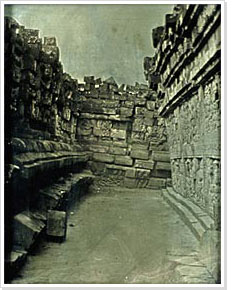Pioneer photography from the Dutch Indies > Adolf Schaefer
 The German daguerreotypist Adolph Schaefer had a photo studio in The Hague. The Ministry of Colonies commissioned him to photograph the Borobudur and other art treasures on Java in 1844. This was the first time that the medium of photography was used to support Dutch archaeological research. In that time, it was still customary to have professional artists copy down the temple reliefs and other archaeological findings on paper.
The German daguerreotypist Adolph Schaefer had a photo studio in The Hague. The Ministry of Colonies commissioned him to photograph the Borobudur and other art treasures on Java in 1844. This was the first time that the medium of photography was used to support Dutch archaeological research. In that time, it was still customary to have professional artists copy down the temple reliefs and other archaeological findings on paper.
Schaefer was forced to work under primitive circumstances. There was for instance no useful space for him to prepare his plates or develop the photographs, which was difficult anyway in the hot, humid climate. On top of this, the Borobudur galleries were too narrow to get the required distance from the reliefs.
Schaefer was unable to frame a complete relief on a single plate. He finally delivered fifty-eight photographs of the Borobudur. But archaeologist Van den Ham wasn't convinced of the usefulness of the daguerreotypes for scientific research. Due to his negative advice to the government and Schaefer's high financial demands, the project wasn't continued.
These daguerreotypes by Schaefer are the first photographs of the archaeological treasures on Java.
From: H.J. Moeshart, Adolph Schaefer and Borobudur, in Toward Independence, A Century of Indonesia Photographed, San Francisco 1991, pp. 20-28
H.J. Moeshart, Adolph Schaefer, A History of Dutch photography in monographs en themed articles, Antwerpen (Voetnoot) 1984-present (in episodes)
